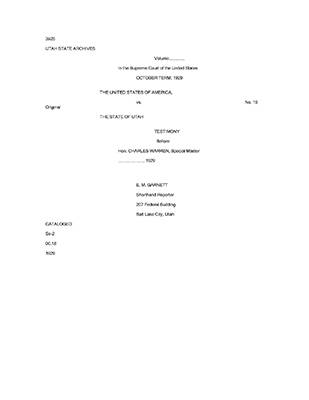- Browse by:
- Collections
- Institutions
- Topics
Conservation
Colorado Riverbed Case
Transcripts of the Colorado Riverbed Case. This case grew out of a desire by the State of Utah to determine who owned the bed of the Colorado River. Utah wanted to drill for oil and for other economic purposes in the bed of the river, but it first had to be determined who owned it, Utah or the United States. This hinged on whether the Colorado could be declared a navigable or a non-navigable river. The U.S. Supreme Court began acquiring testimony in October 1929. The final decree was issued in 1931, giving possession of the riverbed to the United States in non-navigable sections of the river in Utah. Possession of the riverbed in navigable sections of the basin was given to the State of Utah.
Transcripts of the Colorado Riverbed Case. This case grew out of a desire by the State of Utah to determine who owned the bed of the Colorado River. Utah wanted to drill for oil and for other economic purposes in the bed of the river, but it first had to be determined who owned it, Utah or the United States. This hinged on whether the Colorado could be declared a navigable or a non-navigable river. The U.S. Supreme Court began acquiring testimony in October 1929. The final decree was issued in 1931, giving possession of the riverbed to the United States in non-navigable sections of the river in Utah. Possession of the riverbed in navigable sections of the basin was given to the State of Utah.
Hidden Water - Salt Lake County Water Drainages
Hidden Water unveils surface water systems on the east side of Salt Lake Valley, both culinary and irrigation. The web site follows the seven major streams of the Wasatch Front, plus minor ones, and tracks that water from headwaters to the Jordan River and then Great Salt Lake. It intermixes contemporary photographs with historical photographs from several archives showing earlier uses and diversions of water.
Hidden Water unveils surface water systems on the east side of Salt Lake Valley, both culinary and irrigation. The web site follows the seven major streams of the Wasatch Front, plus minor ones, and tracks that water from headwaters to the Jordan River and then Great Salt Lake. It intermixes contemporary photographs with historical photographs from several archives showing earlier uses and diversions of water.
Western Waters Books
Texts on water rights laws in the western states and the Colorado River.
Texts on water rights laws in the western states and the Colorado River.
Western Waters Documents
Documents and reports related to water conservation.
Documents and reports related to water conservation.




